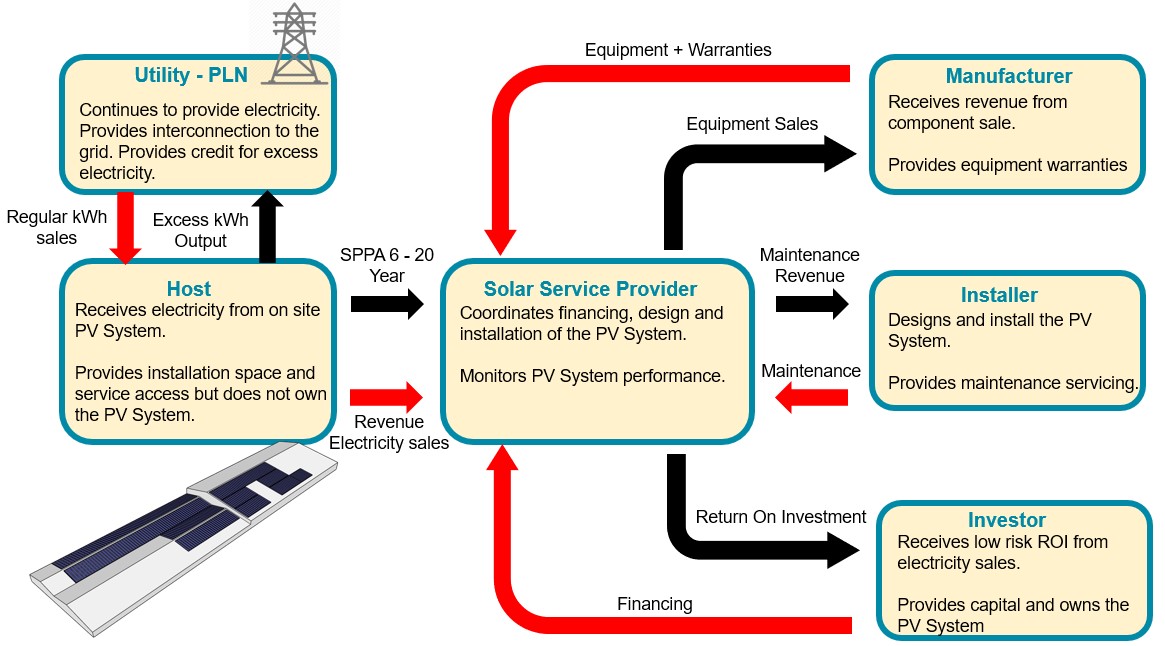| Zero Investment PV Systems |
 |
| 5.2 Mega Watt On Grid PV Systeem East Java |
| Zero Investment PV Systems |
|
Zero investment PV Plant realisation can be available for you if your load consumption is high enough. In indonesia the industry of manufacturing is quite big. These branches most of the time are housed in huge factory halls. These halls provide many square meters of roofspace. This roofspace can earn money for you as a factory owner against a zero investment. |
| Solar Power Purchase Agreement (SPPA) |
| A Solar Power Purchase Agreement (SPPA) is a financial arrangement in which a third-party developer owns, operates, and maintains the photovoltaic (PV) system, and a host customer agrees to site the system on its property and purchases the system's electric output from the solar services provider for a predetermined period. This financial arrangement allows the host customer to receive stable and low-cost electricity, while the solar services provider acquires valuable financial benefits, such as income generated from the sale of electricity. |
| The Host |
| A host customer agrees to have solar panels installed on its property, typically its roof, and signs a long-term contract with the solar services provider to purchase the generated power. The host property can be either owned or leased (note that for leased properties, solar financing works best for customers that have a long-term lease). The purchase price of the generated electricity is typically below, the retail electric rate the host customer would pay its utility service provider. SPPA rates can be fixed, but they often contain an annual price escalator in the range of 1 to 5 percent to account for system efficiency decreases as the system ages; inflation-related cost increases for system operation, monitoring, and maintenance; and anticipated increases in the price of grid-delivered electricity. An SPPA is a performance-based arrangement in which the host customer pays only for what the system produces. The term length of most SPPAs can range from six years to as long as 25 years. |
| The solar services provider |
| The solar services provider functions as the project coordinator, arranging the financing, design, permitting, and construction of the system. The solar services provider purchases the solar panels for the project from a PV manufacturer, who provides warranties for system equipment. |
 |
| The installer |
| The installer will design the system, specify the appropriate system components, and may perform the follow-up maintenance over the life of the PV system. To install the system, the solar services provider might use an in-house team of installers or have a contractual relationship with an independent installer. Once the SPPA contract is signed, a typical installation can usually be completed in three to six months. |
| The investor |
| An investor provides equity financing and receives the federal and state tax benefits for which the system is eligible. Under certain circumstances, the investor and the solar services provider may together form a special purpose entity for the project to function as the legal entity that receives and distributes to the investor payments from tax benefits and the sale of the system’s output. |
| The utility company |
| The utility serving the host customer provides an interconnection from the PV system to the grid, and continues its electric service with the host customer to cover the periods during which the system is producing less than the site's electric demand. There is a possibility of net metering that provide a method of crediting customers who produce electricity on-site in excess of their own electricity consumption. |
| Benefits for host customer |
| No upfront capital cost. |
| Predictable energy pricing. |
| Huge savings on PLN Bills |
| No system performance or operating risk. |
| Visibly demonstrable environmental commitment. |
| Potential increase in property value. |
| Support for local economy and job creation. |
| Want to know more? |
| Contact us |
| Jump to 5,2 MW PV System Project |
| Home |


